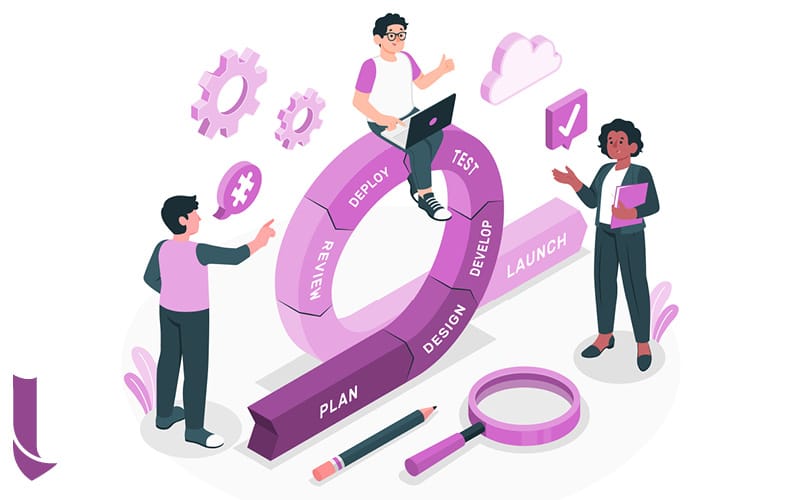SCRUM: A RIGOROUS FRAMEWORK SERVING GREAT ADAPTABILITY

The Scrum method is one of the most popular and widely used Agile methodologies in project management, especially in software development. Its success is based on its ability to enable teams to work collaboratively while offering great flexibility to adapt to frequent and unexpected changes.
Origins and Principles
Scrum was formalized in the 1990s by Jeff Sutherland and Ken Schwaber, who sought to improve the management of complex projects and maximize the teams' ability to respond quickly to changing client requirements. The term “Scrum” comes from rugby, where it refers to a scrum, which symbolizes teamwork and the intense collaboration necessary to move forward together towards a common goal.
Scrum is based on three fundamental pillars:
- Transparency: Significant aspects of the process must be visible to everyone, so that each team member understands the tasks to be completed and the expectations.
- Inspection: The different elements of the work and the progress made are regularly examined to detect any deviations from the goals.
- Adaptation: If a deviation or problem is identified, the process is adjusted to correct the project's trajectory.
Key Roles
Scrum defines three main roles, each with specific responsibilities:
- The Product Owner (PO):
- Responsible for managing the Product Backlog (the prioritized list of items to be developed).
- Defines the priorities and ensures the team develops the features that bring the most value to the client.
- Acts as the main point of contact between the development team and external stakeholders.
- The Scrum Master:
- Serves as a facilitator for the Scrum team, ensuring that Scrum processes are followed.
- Helps the team remove any obstacles that could hinder their progress.
- Promotes a healthy working environment and ensures continuous improvement within the team.
- The Development Team:
- A group of professionals responsible for designing, developing, testing, and delivering features.
- Self-organized and interdisciplinary, the team collectively decides how to achieve the objectives set by the Product Owner.
Ceremonies and Artifacts
Scrum is structured around short and regular work cycles called Sprints, typically lasting between two to four weeks. Each sprint aims to deliver a potentially deliverable product increment.
The Scrum method is built around Artifacts:
- Product Backlog: The prioritized list of features, improvements, and fixes to be made to the product.
- Sprint Backlog: The selection of items from the Product Backlog that the team commits to completing during the sprint.
- Increment: The result of the work done during the sprint, which must be a usable and potentially deliverable product.
And a number of ceremonies that structure the Sprint from start to finish:
- Sprint Planning:
- This meeting marks the beginning of the sprint. The team selects the items from the Product Backlog that will be developed during the sprint.
- The Product Owner presents the priorities, and the development team plans the necessary work to achieve the sprint goals.
- Items are selected based on their value; items that bring the most value to the product are usually selected first.
- A Sprint Goal is defined based on the selected items, which sets the intention and gives a name to the increment to be created.
- After this ritual, the Sprint begins.
- Daily Scrum Meeting:
- This is a short daily meeting, lasting no more than 15 minutes, where each team member gives a quick and overall update on their work. Often, this exercise is summarized by answering three brief questions: What did I do yesterday? What will I do today? What obstacles are we encountering?
- This event aims to synchronize the team and quickly identify potential issues. However, this meeting is not meant to go into details or dwell on specific cases. The goal is to provide an overview of who is working on what and whether everything is progressing according to the plan. If difficulties are raised during this meeting or if a detail needs further discussion, it’s recommended to dedicate a separate meeting to address the issue outside of this event.
- Sprint Review:
- At the end of the sprint, the team presents the finished product increment to the Product Owner and stakeholders to gather feedback. This is the opportunity to showcase what has been accomplished and discuss the next steps. The Sprint Review is often accompanied by a demo when possible.
- Sprint Retrospective:
- This is an internal meeting where the team discusses what went well, what could be improved, and what actions to take for the next sprint. This regular introspection helps the team continuously improve by observing dysfunctions, misunderstandings, and shortcomings, exposing them to the team so they can find solutions to avoid repeating them. This is the most important instance in the Scrum method and aligns with the empirical principle of continuous improvement.
Advantages & Conclusion
Scrum offers many benefits, which explains its growing popularity across various industries:
- Flexibility and Adaptability: Thanks to short sprints and retrospectives, Scrum allows for rapid integration of changes and adjustment of the product to the evolving needs of clients.
- Frequent Deliveries: Frequent delivery of increments enables stakeholders to see progress regularly and provide rapid feedback, reducing the risks of major deviations from expectations.
- Continuous Improvement: With regular retrospectives, the Scrum team constantly strives to improve its efficiency, communication, and the quality of its work.
- Enhanced Collaboration: Scrum encourages constant and transparent communication, not only within the team but also with stakeholders, reinforcing collaboration and engagement from all parties.
Scrum is a powerful method for managing complex projects in an ever-changing environment. By focusing on transparency, inspection, and adaptation, Scrum allows teams to collaborate effectively, improve continuously, and deliver quality products that meet clients’ changing needs. Whether in software development, marketing, or research, Scrum provides a flexible and effective framework to achieve ambitious goals successfully.
